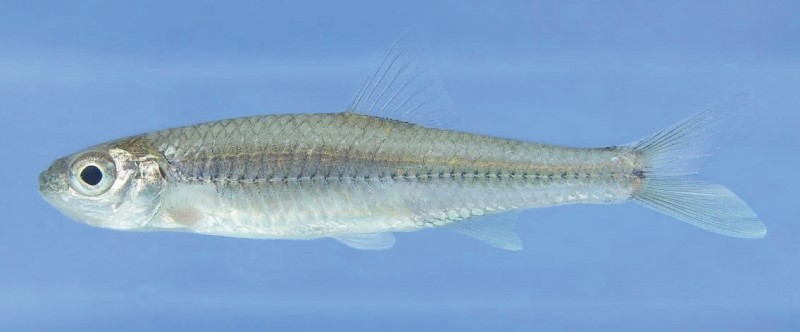Mimic Shiner (Notropis volucellus) - Introduced

Mimic shiners look like spottail shiners except that their mouths reach the ends of their snouts and their eyes are larger.
Identification. Similar to spottail shiner. Eye large (1/3 of head length). Mouth terminal (reaches end of snout). Dorsal rays 9 (first ray short and attached to second). Anal rays 8. Lateral line complete, with 39-40 scales. Lateral line elevated with a dark spot above and below each pore. V-shaped black pigment spot behind anus with some pigment along base of anal fin. Silvery fading to white on belly.

One fairly reliable field characteristic of mimic shiners is the V-shaped area of dark pigment behind the anus. Other Connecticut shiners lack this pigment.
Size. Commonly 1 to 2 inches. State survey max. size 2.8 inches. Max. reported size 4 inches.
Distribution. Native range includes southern Canada and Minnesota south to east Texas and east to the western Appalachians. Scattered populations also exist east of the Appalachians in Virginia and North Carolina. Introduced in a few areas of the Eastern United States, probably due to bait bucket releases. The only known occurrence in Connecticut is West Hill Pond, New Hartford, where it is common to abundant.

Habits. Prefer sandy pools, as well as riffles, in small, clear streams to medium-sized rivers. Also found in lakes. Can be caught with a small-mesh dip net or seine.
Comments. A very “generic” looking minnow that is difficult to identify without magnification. The occurrence of this species in Connecticut was first confirmed in 2004. Small minnows captured from West Hill Pond since the early 1990s and previously identified as golden or spottail shiners may have all been mimic shiners. Established populations of mimic shiners have been reported from the Connecticut River in Massachusetts. It is unlikely, however, that the West Hill Pond population could have originated from there because dams on the Farmington River prevent upstream migration. The West Hill Pond population probably originated from a bait bucket release.

Looking a lot like other shiners gave the mimic shiner its name.
Text and images adapted from Jacobs, R. P., O'Donnell, E. B., and Connecticut DEEP. (2009). A Pictorial Guide to Freshwater Fishes of Connecticut. Hartford, CT. Available for purchase at the DEEP Store. The fish distribution maps were created in 2009. For updated fish distributions please use the CT DEEP Fish Community Data Interactive Map.

